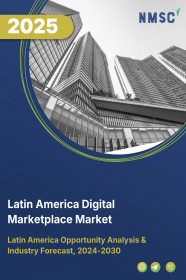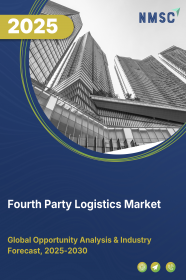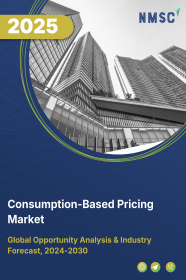
Digital Marketplace Market by Product/Service Type (Physical Goods, Digital Goods, Services, and Event & Ticket Sales), by Platform (Desktop, Mobile, and Tablets), by Model Type (Business to Business (B2B), Business to Consumer (B2C), and Consumer to Consumer (C2C)), and by End Users (Commercial, and Personal) - Opportunity Analysis and Industry Forecast, 2024 – 2030
Industry: ICT & Media | Publish Date: 07-Oct-2025 | No of Pages: 209 | No. of Tables: 149 | No. of Figures: 96 | Format: PDF | Report Code : IC2261
Latin America Digital Marketplace Market Overview
The Latin America Digital Marketplace Market size was valued at USD 27.62 billion in 2023, and is predicted to reach USD 36.46 billion by 2030, at a CAGR of 3.9% from 2024 to 2030. Digital marketplace market, also referred to interchangeably as online marketplaces or digital commerce platforms, serve as virtual hubs where individuals engage in the buying or selling of goods, services, or information. These platforms function as intermediaries, facilitating transactions among various parties, including buyers and sellers, within a centralized online environment designed for effortless product discovery, purchasing, and delivery. Prominent examples of online marketplaces encompass well-established e-commerce platforms like Amazon, eBay, and Alibaba, along with service-oriented platforms such as Upwork and Fiverr.
Leveraging advanced technology, these platforms streamline transaction processes, ensuring swift and secure payment processing while safeguarding the financial data of all involved parties. Additionally, they enhance user experiences by offering features such as customer reviews, ratings, and mechanisms for resolving transaction-related issues. Consequently, online marketplaces leverage technology to improve the overall online shopping experience, rendering it more convenient and secure for both buyers and sellers. They play an indispensable role in the modern economy by bridging the gap between businesses and consumers across diverse geographic locations, thereby facilitating seamless and convenient global commerce.
Mobile-First Ecosystem and Super-App Expansion Driving Marketplace Demand
The Latin American digital marketplace is being propelled by the dominance of mobile commerce and the emergence of multi-service platforms that integrate shopping, payments, logistics, and even entertainment into a single ecosystem. A growing share of consumers across the region now access marketplaces primarily through their smartphones, creating a mobile-first environment where convenience and accessibility are the strongest value propositions.
This shift has opened the door for the rapid growth of “super-apps,” which bundle a wide range of services into one digital environment. These platforms allow users to shop, pay, order food, book services, and even access credit, all without leaving the app. The expansion of such ecosystems is not only improving engagement but also strengthening customer loyalty by reducing the need to juggle multiple platforms. As a result, digital marketplaces are increasingly becoming central hubs in consumers’ daily lives, positioning mobile-first innovation as one of the most powerful drivers of sustained growth in the region.
Fintech Inclusion and Real-Time Payments Unlocking Market Potential
Another powerful driver of digital marketplace growth in Latin America is the rapid expansion of fintech solutions and real-time payment systems. The region has historically been characterized by high levels of cash usage and large unbanked populations, which created barriers to digital participation. Today, government-backed initiatives and fintech innovation are closing this gap by providing secure, low-cost, and immediate payment options.
Instant payment networks and digital wallets are transforming the financial landscape by giving millions of consumers and small businesses their first reliable entry point into online commerce. These tools not only reduce friction in transactions but also build trust by ensuring secure, traceable, and accessible payments. For digital marketplaces, this means access to entirely new customer segments and the ability to scale more inclusively across diverse income groups. In parallel, merchants and entrepreneurs benefit from faster settlement times and reduced costs, enabling them to participate more actively in the digital economy. Together, financial inclusion and real-time payments are creating a foundation that strengthens both the supply and demand sides of the marketplace ecosystem.
Logistics and Infrastructure Gaps Limiting Equitable Market Expansion
While digital marketplaces in Latin America are experiencing rapid growth, persistent logistics and infrastructure challenges remain a major restraint on the sector’s ability to scale inclusively. Delivery networks are often fragmented, particularly outside metropolitan centers, where inadequate transport systems, limited warehousing capacity, and unreliable last-mile connectivity make it difficult to guarantee timely and cost-efficient fulfillment. Rural and semi-urban areas, despite showing rising digital adoption, continue to face barriers in accessing the same level of service quality available in major cities.
These constraints increase operational costs for platforms and erode customer satisfaction when delays, high shipping fees, or restricted product availability occur. Small and medium-sized sellers are particularly affected, as they lack the resources to negotiate with large logistics providers or maintain their own delivery networks. Although investments in fulfillment centers, partnerships with local couriers, and the adoption of smart logistics technologies are improving conditions, uneven infrastructure development still hampers the full realization of digital marketplace potential across the region. Addressing these gaps will be critical to ensuring equitable growth and broader participation in the digital economy.
Cross-Border Digital Commerce Expansion Unlocking Regional Integration Opportunities
One of the most promising opportunities for Latin America’s digital marketplace lies in the expansion of cross-border e-commerce, supported by regional trade agreements, advancing payment interoperability, and improving logistics corridors. As consumers become more comfortable purchasing from international platforms and local sellers gain tools to reach global buyers, cross-border trade is emerging as a powerful growth lever. This trend is fueled by increasing demand for diverse products, competitive pricing, and access to international brands that may not be available locally.
For businesses, cross-border marketplace integration offers the chance to tap into larger regional and global customer bases while diversifying revenue streams. Investments in digital customs clearance, unified tax frameworks, and regional fulfillment networks are gradually reducing the frictions that historically limited international online trade. As fintech solutions enable secure multi-currency transactions and real-time payment systems become more widely adopted, Latin America is positioned to become a more interconnected digital commerce hub. Harnessing this opportunity could significantly accelerate growth, positioning marketplaces as key enablers of regional economic integration and global competitiveness.
Competitive Landscape
The key market players operating in the Latin America digital marketplace industry include Mercado Libre, Inc., Amazon.com, Inc., Americanas S.A., Magazine Luiza S.A., Falabella S.A., Sea Limited (Shopee), Despegar.com, Corp., iFood, Rappi Inc., OLX Group, Global Fashion Group (Dafiti), Walmart de México y Centroamérica, Enjoei S.A., MadeiraMadeira (Tenda S.A.), Properati, and others.
Latin America Digital Marketplace Market Key Segments
By Product/Service Type
-
Physical Goods
-
Electronics
-
Clothing
-
Food
-
Furniture
-
Handbag & Accessories
-
Others
-
-
Digital Goods
-
Software
-
E-Books
-
Music & Videos
-
Games
-
-
Services
-
Freelancing
-
Education
-
Consultations
-
Others
-
-
Event & Ticket Sales
By Platform
-
Desktop
-
Mobile
-
Tablets
By Model Type
-
Business To Business (B2b)
-
Business To Consumer (B2c)
-
Consumer-To-Consumer (C2c)
By End User
-
Commercial
-
Personal
By Region
-
Latin America
-
Brazil
-
Mexico
-
Argentina
-
Colombia
-
Chile
-
Peru
-
Other Countries
-
Key Players
-
Mercado Libre, Inc.
-
Amazon.com, Inc.
-
Americanas S.A.
-
Magazine Luiza S.A.
-
Falabella S.A.
-
Sea Limited (Shopee)
-
Despegar.com, Corp.
-
iFood
-
Rappi Inc.
-
OLX Group
-
Global Fashion Group (Dafiti)
-
Walmart de México y Centroamérica
-
Enjoei S.A.
-
MadeiraMadeira (Tenda S.A.)
-
Properati
REPORT SCOPE AND SEGMENTATION:
|
Parameters |
Details |
|
Market Size in 2023 |
USD 27.62 Billion |
|
Revenue Forecast in 2030 |
USD 36.46 Billion |
|
Growth Rate |
CAGR of 3.9% from 2024 to 2030 |
|
Analysis Period |
2023–2030 |
|
Base Year Considered |
2023 |
|
Forecast Period |
2024–2030 |
|
Market Size Estimation |
Billion (USD) |
|
Growth Factors |
|
|
Companies Profiled |
15 |
|
Market Share |
Available for 10 companies |
|
Customization Scope |
Free customization (equivalent up to 80 working hours of analysts) after purchase. Addition or alteration to country, regional, and segment scope. |
|
Pricing and Purchase Options |
Avail customized purchase options to meet your exact research needs. |

















 Speak to Our Analyst
Speak to Our Analyst
























